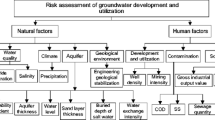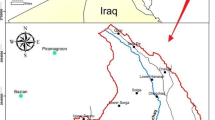Abstract
With the rapid development of economy, demand of water resources is becoming larger and larger, and over-exploitation of groundwater is common in many areas. Due to over-exploitation of groundwater over many years, a number of potential adverse hydrogeological problems have raised. To reduce such adverse effects, it is necessary to carry out strict groundwater management in over-exploited areas. And to achieve the strictest management of groundwater, it is critical to determine control levels of groundwater including the blue line levels (proper levels) and red line levels (warning levels). According to the establishment of evaluation model of shallow and deep groundwater exploitation and utilization risks, it can be observed that the groundwater level index factor is included in the evaluation index system in different groundwater function zones. Therefore, there is a corresponding relationship between the risk grade and groundwater level of different underground aquifers. The risk grade of different groundwater function zones in Tianjin is divided into five grades, which contributes to the risk management of groundwater, avoiding the arising of a wide range of risk management measure. However, to determine the key groundwater level, the standard of five grades cannot meet the requirements. The risk grades need to be divided more subtly. Hence, in this paper, the risk grade was divided according to the standard of sixteen grades based on that of five grades in the first place. The higher the grade is, the greater the risk. And then the occurrence frequency of risk grade for each aquifer was counted in each administrative district or country. The corresponding water level of the risk grade, whose occurrence frequency was the highest, served as the base level. The water level of groundwater that would be exploited and utilized in the future cannot be below this base level. In consequence, this water level that served as the red line level was the minimum requirement in the planning years, while the corresponding water levels of other risk grades that were inferior to this risk grade can all be seen as red line levels. And the planning period the long-term corresponding groundwater level of the aquifers under mining-banned condition can be used as blue line control levels of the different planning years. Finally, according to the determinate range of red line level change amplitude in each district or country, as well as the ultimate restoration aim of groundwater levels (blue line levels), corresponding measures were taken step by step to achieve the overall rising of groundwater levels. The obtained determinate control levels can provide a scientific basis for dynamic management of groundwater.










Similar content being viewed by others
References
Adamowski J, Chan HF (2011) A wavelet neural network conjunction model for groundwater level forecasting. J Hydrol 407:28–40. doi:10.1016/j.jhydrol.2011. 06.013
Behzad M, Asghari K, Coppola EA (2010) Comparative study of SVMs and ANNs in aquifer water level prediction. J Comput Civil Eng 24:408–413. doi:10.1061/(ASCE) CP.1943-5487.0000043
Coulibaly P, Anctil F, Aravena R, Bobee B (2001) Artificial neural network modeling of water table depth fluctuations. Water Resour Res 37:885–896. doi:10.1029/2000 WR900368
Daliakopoulos IN, Coulibaly P, Tsanis IK (2005) Groundwater level forecasting using artificial neural networks. J Hydrol 309:229–240. doi:10.1016/j.jhydrol.2004.12. 001
Dash NB, Panda SN, Remesan R, Sahoo N (2010) Hybrid neural modeling for groundwater level prediction. Neural Comput Appl 19:1251–1263. doi:10.1007/ s00521-010-0360-1
Dong DL, Sun WJ, Zhu ZC, Xi S, Lin G (2013) Groundwater risk assessment of the third aquifer in Tianjin city, China. Water Resour Manage 27:3179–3190. doi:10.1007/s11269-013-0342-z
Fadlelmawla AA, Fayad M, El-Gamily H, Rashid T, Mukhopadhyay A, Kotwicki V (2001) A land surface zoning approach based on three-component risk criteria for groundwater quality protection. Water Resour Manag 25(6):1677–1697. doi:10.1007/s11269-010-9767-9
Feng SY, Huo ZL, Kang SZ, Tang ZJ, Wang FX (2011) Groundwater simulation using a numerical model under different water resources management scenarios in an arid region of China. Environ Earth Sci 62:961–971. doi:10.1007/s12665-010-0581-8
Huysmans M, Madarász T, Dassargues A (2006) Risk assessment of groundwater pollution using sensitivity analysis and a worst-case scenario analysis. Environ Geol 50(2):180–193. doi:10.1007/s00254-006-0197-1
Janga RM, Poulomi G (2012) Risk assessment of hydroclimatic variability on groundwater levels in the Manjara basin aquifer in India using Archimedean copulas. J Hydrol Eng 17:1345–1357. doi:10.1061/(ASCE) HE 1943- 5584.0000564
Kabbour BB, Zouhri L, Mania J, Colbeaux JP (2006) Assessing groundwater contamination risk using the DASTI/IDRISI GIS method: coastal system of western Mamora, Morocco. Bull Eng Geol Environ 65:463–470. doi:10.1007/s 10064-004-0265-2
Li FW, Feng P, Zhang W, Zhang T (2013) An integrated groundwater management mode based on control indexes of groundwater quantity and level. Water Resour Manag 27:3273–3292. doi:10.1007/s11269-013-0346-8
Liu CW, Lin CN, Jang CS, Chen CP, Chang JF, Fan CC, Lou KH (2006) Sustainable groundwater management in Kinmen Island. Hydrol Process 20:4363–4372. doi:10.1002/hyp.6171
Maheswaran R, Khosa R (2013) Long term forecasting of groundwater levels with evidence of non-stationary and nonlinear characteristics. Comput Geosci 52:422–436. doi:10.1016/j.cageo.2012.09.030
Milnes E (2011) Process-based groundwater salinisation risk assessment methodology: application to the Akrotiri aquifer (Southern Cyprus). J Hydrol 39(1–2):29–47. doi:10.1016/j.jhydrol.2010.12.032
Moreaux M, Reynaud A (2006) Urban freshwater needs and spatial cost externalities for coastal aquifers: a theoretical approach. Reg Sci Urban Econ 36(2):163–186. doi:10.1016/j.regsciurbeco.2005.09.002
Nayak PC, Rao YRS, Sudheer KP (2006) Groundwater level forecasting in a shallow aquifer using artificial neural network approach. Water Resour Manage 20:77–90. doi:10.1007/s11269-006-4007-z
Ong’or B, Shu LC, Liu PG (2007) Environmental impact assessment of risk associated with groundwater overdraft remediation in cone of depression, Jining, China. Environ Geol 53:751–762. doi:10.1007/s00254-007-0687-9
Pisinaras V, Petalas C, Tsihrintzis VA, Zagana E (2007) A groundwater flow model for water resources management in the Ismarida plain, North Greece. Environ Model Assess 12:75–89. doi:10.1007/s10666- 006-9040-z
Praveena SM, Abdullah MH, Bidin K, Aris AZ (2012) Sustainable groundwater management on the small island of Manukan, Malaysia. Environ Earth Sci 66:719–728. doi:10.1007/s12665-011-1279-2
Qureshi AS, McCornick PG, Sarwar A, Sharma BR (2010) Challenges and prospects of sustainable groundwater management in the Indus Basin, Pakistan. Water Resour Manag 24:1551–1569. doi:10.1007/s11269-009- 9513–3
Saidi S, Bouri S, Ben Dhia H (2010) Groundwater vulnerability and risk mapping of the Hajeb-jelma aquifer (Central Tunisia) using a GIS-based DRASTIC model. Environ Earth Sci 59:1579–1588. doi:10.1007/s 12665-009-0143-0
Sener E, Davraz A (2013) Assessment of groundwater vulnerability based on a modified DRASTIC model, GIS and an analytic hierarchy process (AHP) method: the case of Egirdir Lake basin (Isparta, Turkey). Hydrogeol J 21:701–714. doi:10.1007/s10040-012-0947-y
Shao J.L. Cui Y.L. Wang L.C.2010. Deep groundwater mining situation and research on the numerical simulation and prediction of groundwater in Tianjin. Beijing:China University of Geosciences (in Chinese).
Taormina R, Chau KW, Sethi R (2012) Artificial neural network simulation of hourly groundwater levels in a coastal aquifer system of the Venice lagoon. Eng Appl Artif Intel 25:1670–1676. doi:10.1016/j.engappai.2012. 02.009
Tsanis LK, Coulibaly P, Daliakopoulos LN (2008) Improving groundwater level forecasting with a feedforward neural network and linearly regressed projected precipitation. J Hydroinform 10:317–330. doi:10.2166/hydro. 2008.006
Wang JJ, He JT, Chen HH (2012) Assessment of groundwater contamination risk using hazard quantification, a modified DRASTIC model and groundwater value, Beijing Plain, China. Sci Total Environ 432:216–226. doi:10.1016/j.scitotenv.2012.06.005
Xie XM, Chai FX, Yan Y, Zhang JQ, Yang LL (2007) Preliminary study on critical depth of ground water table. Ground Water 29(6):47–50 (in Chinese)
Yang ZP, Lu WX, Long YQ (2009) Application and comparison of two prediction models for groundwater levels:A case study in Western Jilin province, China. J Arid Environ 73:487–492. doi:10.1016/j.jaridenv.2008.11. 008
Acknowledgments
The authors would like to acknowledge the financial support for this work provided by the Science Fund for Creative Research Groups of the National Natural Science Foundation of China (Grant no.51021004), Ministry of Water Resources Special Funds for Scientific Research on Public Causes (201401041), and Tianjin Research Program of Application Foundation and Advanced Technology (Grant no. 12JCQNJC05200).
Author information
Authors and Affiliations
Corresponding author
Rights and permissions
About this article
Cite this article
Li, F., Qiao, J., Zhao, Y. et al. Risk Assessment of Groundwater and its Application. Part II: Using a Groundwater Risk Maps to Determine Control Levels of the Groundwater. Water Resour Manage 28, 4875–4893 (2014). https://doi.org/10.1007/s11269-014-0784-y
Received:
Accepted:
Published:
Issue Date:
DOI: https://doi.org/10.1007/s11269-014-0784-y




